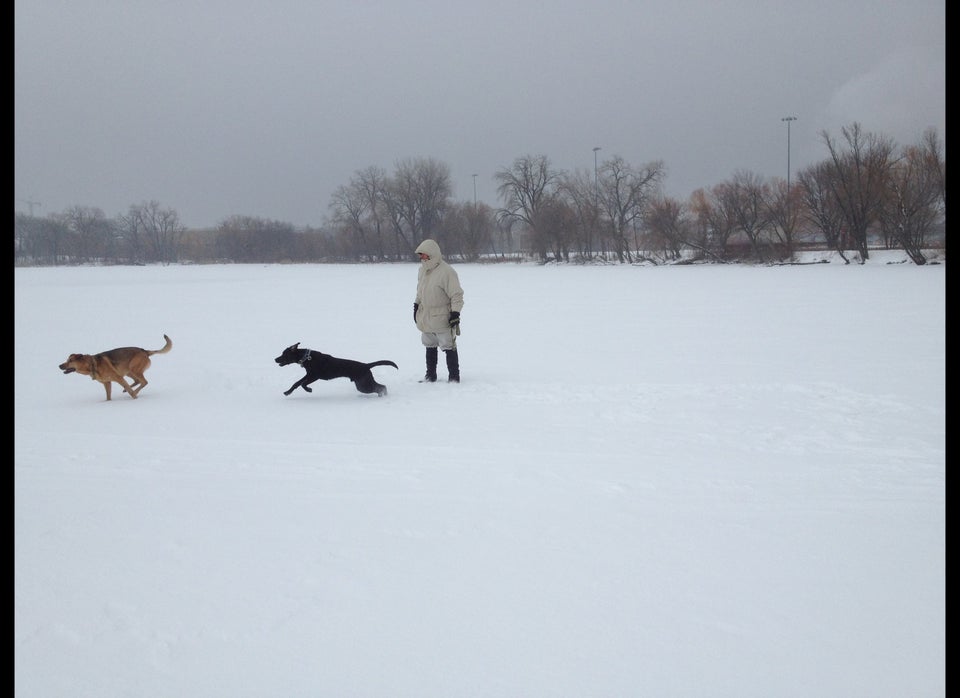Global warming may exist, but winter is still upon us, and our pets can feel the chill.
A pet on the lap is a simple and wonderful way to lower heating bills, but what can we do to reduce their risk of illness from the tolls of winter?
Even if your cat or dog is accustomed to spending time outdoors, don't assume that he or she can withstand all harsh winter conditions. Even some large dog breeds that are adapted to extremely low temperatures are still susceptible to injury from cold.
Outdoor cats may warm themselves near car tires or even in a warm engine. Make sure you know where your outdoor cat is during cold weather before you start your engine.
More pets are lost in winter than in any other season. Dogs may lose their scent and even lose their way in extreme cold. Keep your dog on a leash if he or she is likely to wander during bitter cold snaps.
The Salt of the Earth
No matter what breed, an animal's paws should be vigilantly cared for in urban areas where salt is omnipresent. Salt is caustic and painful to the feet.
Detrimental Effects Caused by Salt and Ice:
- Cracked, bleeding or ulcerated pads
- Uncomfortable ice balls between toes and pads
- Inflamed mouth or gastrointestinal tract from licking salt
Simple Tips for Happy Winter Feet
- Keep salt out of the wound and off the feet by using booties, socks, or topical wax (I use Musher's Secret) on the paws for those who won't wear boots.
- Wiping the foot off with fresh snow, or having the dog walk through clean snow can remove salt residue and improve limping from salt irritation during a walk.
- Leave a shallow tray with a wet towel in the bottom by the door -- the pet can step in to remove most of the salt on paws. Or use a wet towel by hand to wipe the feet.
- Dry cracked skin and pads can benefit from topical coconut oil.
- Booties are best if they are light and not too bulky. Doggie socks sprayed with plastic sealant are a good option for light duty.
- An empty IV fluid bag, laced at the top can serve as an effective waterproof covering over bulky leg casts, foot bandages, or wraps -- ask your vet for one.
Feed a Cold
Nutritional needs increase in winter months. Pets may be more susceptible to illness in cold, dry weather. In the wild, animals put on weight to protect them from winter's cold, and lose it in the summer. I don't ever recommend any pet become fat for the winter, but being a little heavier during cold months makes sense. Increase food amounts for a very thin dog or cat.
Nutritional and Topical Supplements
These may help moisturize winter skin in cats and dogs.
- Omega-3 from fish oil, algae DHA (Omega-3), coconut oil or olive oil as a daily supplement.
- Don't over-bathe in dry winter weather, you can deplete the skin of its own natural oils. Use a dog conditioner after shampooing.
- Dogs and cats overall intestinal health can benefit from a good quality probiotic sprinkled on food the winter.
- If the nose is dry and cracked, topical Vaseline or Waxelene works wonders.
- Winter's cold and indoor heating are dehydrating -- provide extra bowls of water.
Antifreeze -- Great for Your Car, Toxic for Your Pet.
Ingestion of antifreeze by animals is common in winter, and unfortunately, deadly. Cats and dogs are attracted to liquid antifreeze that contains ethylene glycol. This is a strikingly green (sometimes orange) toxic chemical, and ingestion of it can be quickly fatal. Make sure your car isn't leaking antifreeze. If your pet has ingested antifreeze, go to your vet or the ER immediately -- it can be treated.
Cold, Colder, Coldest
Small dogs, older dogs or animals with inadequate hair coats may be more comfortable in a cute little coat. Another option for these dogs is frequent but shorter walks in the winter.
During winter months, remove metal bowls that have been left outside. A dog's or cat's tongue can stick to the freezing metal and cause stress or injury. If your pet depends on an outside water bowl, make sure it has a safe heat source. Frozen water isn't drinkable.
Make sure any frozen water (rivers, ponds, lakes) where your pet may walk is really frozen and safe. Moving waterways don't tend to freeze well. Keep your pet close when near semi-frozen bodies of water.
Shelter for dogs and cats should be just large enough to sit upright and turn around in, so they do not waste heat they produce on a large space.
Inexpensive and effective insulation: newspaper, hay or straw. Animals burrow in the hay and it is easily replaced for cleaning.
While rare in healthy animals, frostbite signs (typically seen on ear-tips, tails or feet) are often only noticeable after the exposure, so keep the length of invigorating walks appropriate to the weather conditions.
I recall walking my German shepherd dog Tundra during a bitter cold snap in the Midwest 20 years ago. She had been delicately lifting one paw after another. This failed to alert me to how cold she was. In desperation, she fell over on her side with all four feet in the air. I thought she had died. But it was just that her feet were cold.
For more by Barbara E. Royal, D.V.M., click here.
For more on pet health, click here.
For more by Barbara E. Royal, D.V.M., click here.
For more on pet health, click here.
